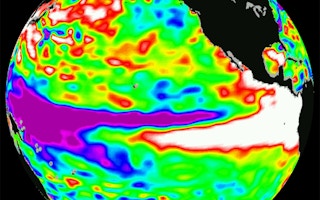An El Niño is part of a natural cycle: a huge blister of heat in the equatorial Pacific, usually around Christmastime, that periodically triggers unseasonal floods in the western US, and extreme heat and forest fires in the Indonesian rainforest and the Australian bush.
It happens and seems to have happened through human history. It has nothing to do with global warming or climate change. Except this: according to the latest study by climate scientists in Australia, the US, China and Britain, global warming is likely to make the most extreme El Niño events happen twice as frequently.
Since an El Niño episode is characterised by – the scientists say in Nature Climate Change – “severely disrupted global weather patterns, affecting ecosystems, agriculture, tropical cyclones, drought, bushfires, floods and other extreme weather events worldwide,” this is unlikely to be welcome news.
Right now, and for the past year, conditions in the equatorial Pacific have been neither unusually warm nor unusually cool. There is no El Niño right now. But for two summers running, even without help from unusual Pacific conditions, Australia has been hit by record temperatures and appalling forest fires, so the news is ominous.
Wenju Cai of Australia’s CSIRO marine and atmosphere research and colleagues report in the journal that extreme El Niño events tend to happen when sea surface temperatures higher than 28°C develop in the normally cool and dry eastern Pacific, to trigger big shifts in the atmospheric convection zones (areas of instability caused by temperature differences), and climate models show that these episodes have normally occurred every 20 years or so.
Profound impact
Now, as carbon dioxide levels rise and the global average temperatures creep up, these extreme events are likely to be twice as frequent: every decade or so.
The last extreme event, in 1997-98, caused an estimated $35 billion (US dollars) in damage and claimed an estimated 23,000 lives worldwide. It also made 1998 the hottest year ever in average global temperatures, a record that lasted for more than a decade.
“The question of how global warming will change the frequency of extreme El Niño events has challenged scientists for more than 20 years. This research is the first comprehensive examination of the issue to produce robust and convincing results”, said Mike McPhaden of the US National Oceanic and Atmospheric Administration, one of the co-authors.
The authors warn that potential future changes in such extreme events could have “profound socio-economic consequences.” They conclude: “With a projected large increase in extreme El Niño occurrences, we should expect more occurrences of devastating weather events, which will have pronounced implications for twenty-first century climate.”










